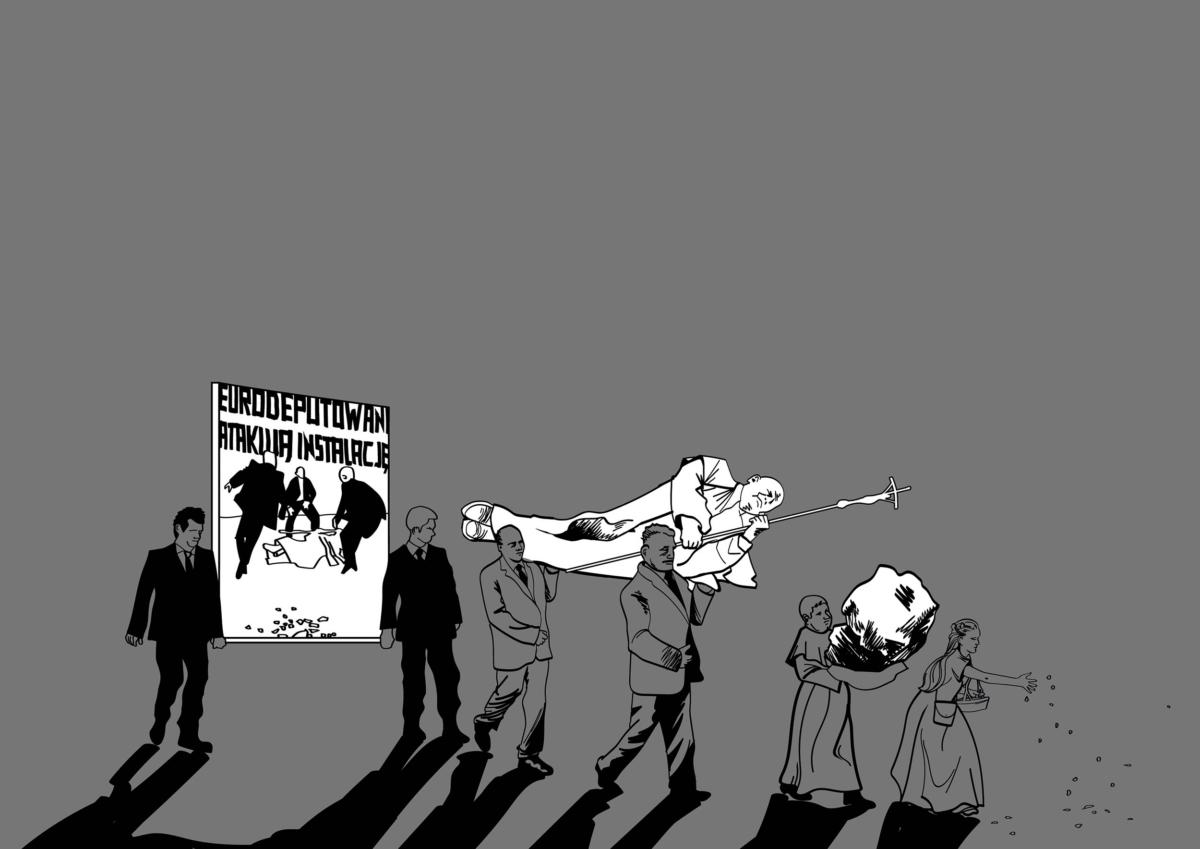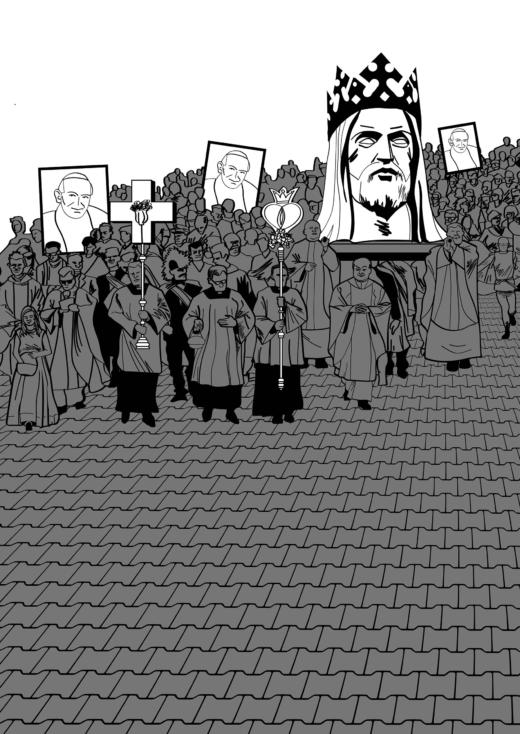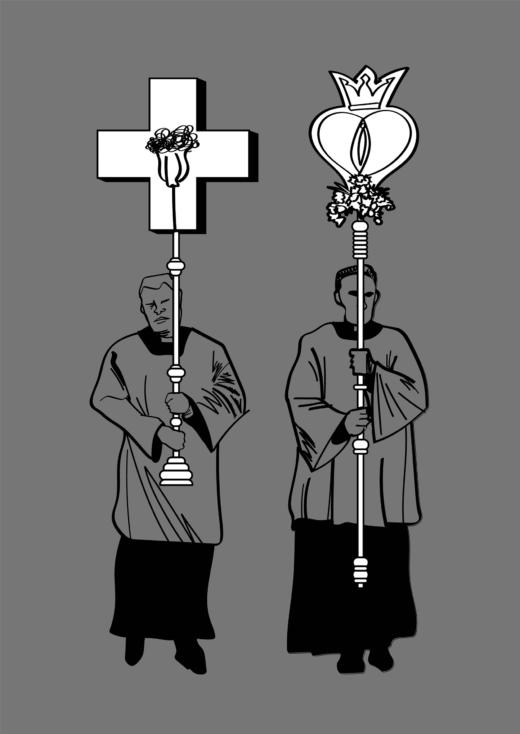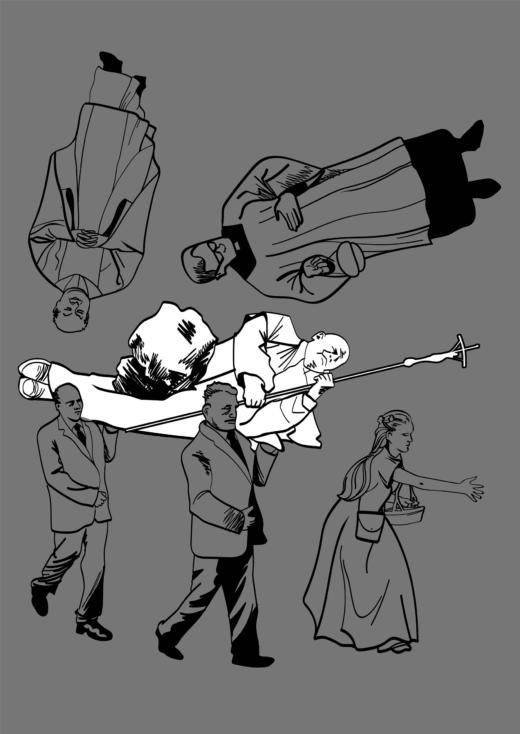
Introduction
In September 2018, amidst an atmosphere of sensation, Wojciech Smarzowski’s feature film Kler broke the record for box office ticket sales in Poland. During its first weekend in theatres, the film, which uncompromisingly depicts the excesses of Polish priests, was seen by nearly a million viewers. In an interview with Newsweek Polska, the film’s director said: “I’ve felt and still feel surrounded by the Church and religion. Religion is everywhere – in the press, on television, in government offices and on the street. The straw that broke the camel’s back was my experience with religion at school. When my sons started their educations, I suddenly realized the scale of the phenomenon. At issue was not just the isolated case of my sons or a particular priest, but the fact that all of this starts at school. Society becomes accustomed from an early age to the ubiquity of the Church in daily life. The result is that our children are brainwashed because they’ve been brought up with these superstitions.”[1]
Piotr Piotrowski, an accomplished art researcher, sees the source of Poland’s unease with the republican principle of the separation of church and state in the problematic nature of the sources of its legitimacy. Like Claude Lefort, he believes that democracy should be an ideologically impartial system. It is the rule of an “empty space”; neither God nor History nor anything else can be an ideological “justification” for a democratic system. Meanwhile, post-communist democracy, at least in Poland, has an ideological foundation, both in terms of theory (its constitution[s]) and in the practical exercise of power. This foundation is the Christian tradition.[2]
The stereotype of the Polish Catholic has a strong presence in global culture, conveyed not only by Hollywood cinema, but also by literature and prominent documentary films, such as Claude Lanzmann’s Shoah. The visual arts in Poland, too, are often described through their attitude to religious tradition. This lens is used to interpret the art of Mirosław Bałka, whose debut in the world of art was his famous graduation project Souvenir from First Communion (1985), and who later explored religious themes in works like St. Adalbert (1987) or Black Pope and Black Sheep (1987), considered one of the artist’s most important early pieces.
At present, two worlds of the imagination – secular-republican and religious-conservative – are in strong competition with one another in Poland. At the heart of the dispute are attitudes to tradition, religion and individual autonomy. The site of this struggle is visual culture in its broadest sense, as in today’s media-saturated societies, images seem to be the quickest and most effective weapon in political disputes. Łukasz Zaremba writes that images have usually not played a major role in Polish social life: “The [current] conflicts over images, especially public disputes […] is one of the rare moments when they [images] have become visible. Images are now playing a role as sources of conflict, as pretexts for disputes, as catalysts for differences, but also as victims of attacks.”[3]

illustration: Adam Jastrzębski
Appropriation
Appropriation is a subversive avant-garde strategy present in political art since at least the beginning of the twentieth century. With time, as the art market developed, it also became an effective marketing strategy. Sebastian Cichocki and Łukasz Ronduda, curators at the Warsaw Museum of Modern Art and organizers of the exhibition Polish National Art in 2012, point out that strategies of appropriation have also been successfully employed by conservative right-wing activists, who with increasingly effectiveness have made use in public space of aesthetic codes developed by the left-wing avant-garde. As a rule, in contrast, actions involving the appropriation of symbols reserved for the conservative side have faced repression in the form of restrictive actions by the legal system. A paradoxical asymmetry can thus be observed here: on the one hand, we have the powerful institutions of the church and government; on the other hand, dispersed and diverse artistic and academic circles. Yet it is this church-conservative conglomerate, which holds power and possesses immense financial and symbolic resources, that complains it is being subjected to wide-scale attacks and persecution.
The mixed feelings and conflicting attitudes of young Poles towards the dominance of the Catholic Church’s narrative is well illustrated by the works of two young artists from this generation: Ada Karczmarczyk and Zofia Kuligowska. Ada Karczmarczyk has created an Internet pop music star who affirms values closely aligned with the church’s narrative. In this work, faith, an attachment to tradition, trust in hierarchies, and praise of patriotism and masculine strength are all expressed in kitschy and campy versions of home-made music videos. From the moment of its release, the work caused a stir on both sides in Poland’s aesthetic and political conflict. It is unclear whether we were dealing here with the subversive “overidentification” described by Slavoi Žizek or straightforward affirmation.[4]
The current political situation in Poland, the expansion of the conservative-nationalist press and the appropriation of public television as a propaganda tube by the right-wing government has made it nearly impossible to perform such a balancing act of artistic allusion. By accepting an offer to broadcast her work on state-run television and publishing it in conservative-religious periodicals, Ada Karczmarczyk inscribed herself in the narrative of what the leader of the ruling party, Jarosław Kaczyński, described as a project for a cultural counter-revolution in Europe. This counter-revolution, apart from dressing up in historical costumes, effectively uses tools developed by the aesthetic avant-garde in the twentieth century and skilfully mixes them with populist and nationalist currents in pop music, such as Balkan turbo-folk or disco-polo, which enjoys immense popularity in Poland.
Two works by Zofia Kuligowska from 2014 occupy polar opposite positions within the above context. One of them was filmed in a popular pilgrimage centre that is famous for its bombastic, kitschy copy of St. Peter’s Basilica, erected in the middle of an empty field near the village of Licheń. In it the artist stands at the top of Golgotha, a hill that symbolizes the place of Christ’s death, near a plaque with a quotation from a poem wrongly attributed to Adam Mickiewicz, the greatest Polish poet of the Romantic period: “Only under this cross, only under this sign, is Poland truly Poland and a Pole truly a Pole.”[5] This thought, formulated in the early nineteenth century, when Poles did not have their own state, is today a leading slogan among supporters of a cultural counter-revolution. The artist, with her back turned toward the plaque and poem, furiously chews colourful chewing gum purchased at the pilgrimage centre.
A similar situation can be observed in her video work Queen, whose action takes place at the foot of the highest statue of Christ the King in Europe, located in Świebodzin near Poland’s western border. The artist, dressed in a plastic crown bought in a nearby shop, once again chews a huge wad of colourful chewing gum. In both cases, the performer looks calmly but challengingly straight into the camera lens. In her attitude, we can see a sign of passive resistance to the dominant religious and patriotic narrative, which seeks to turn citizens aware of their rights into infantile and passive adult-children. In Kuligowska’s work, the monumental statue is an iconic symbol of the cultural war being fought in Poland. Its image is used and appropriated by both sides of the conflict: it is the star of Internet memes and is used as a decoration at football stadiums. In 2012, the monument’s designer, Mirosław Patecki, was invited by Artur Żmijewski to take part in the Berlin Biennale. A 1:1-scale polystyrene copy of the figure’s head, made by the artist in front of a live audience, was available for viewing in the Kunst-Werke Institute for Contemporary Art Berlin. Considering the sculpture’s political dimension, inviting the Christ figure’s author to participate in the Biennial was a controversial and manipulative gesture. It was an attempt to appropriate an icon of provincial religious Poland and place it in quotation marks within its own political narrative.

illustration: Adam Jastrzębski
In 2004, at the invitation of the 27th Art Biennale in São Paolo, Piotr Uklański displayed the photograph untitled (John Paul II). This was a portrait of Karol Wojtyła made up of Brazilian soldiers photographed from a bird’s eye view, who had been positioned in a stadium and instructed to dance the samba according to a drawing prepared by the artist. The work was created according to a technique developed by the photographer Artur Mole, who in 1918 made a portrait of US President Woodrow Wilson comprised of 21,000 American soldiers posing in unison. The work began to live its own life in a way that was completely unexpected by Uklański. As Anda Rottenberg recalls: “It so happened that in April 2005 we displayed it in the form of a billboard in the centre of Warsaw, at the corner of Świętokrzyska and Marszałkowska Streets. This action was connected with the recent opening of the Museum of Modern Art in Warsaw, which had purchased the work for its collection. After the Pope’s death, the billboard became part of the mourning process. People came to the billboard to pray, lay flowers and light candles. I could never have imagined this, even in my wildest dreams.”[6]
We are dealing here with second-degree appropriation, in which a revolutionary call to “loot the looters” is realized. Those viewing the billboard spontaneously recontextualised Uklański’s work to use it for their own purposes, ignoring his intentions and moving it from the realm of art into the realm of the confessional. In Poland, the image of the canonized Polish pope is both an object of religious worship and critical appropriation.
The figure of Karol Wojtyła thus arouses emotions in both apologists for and opponents of the church, and his mythologized media message is particularly conducive to reconfigurations in the visual arts. In 2001, Rafał Bujnowski, a painter born in Wadowice, Karol Wojtyła’s home town, painted a painting titled Draft for a Painting of the Pope. The canvas is divided into six equal rectangles, on which we can follow childishly simple steps that allow anyone, including those deprived of even elementary artistic skills, to paint their own pope. This work is an obvious mockery of the increasing proliferation in Poland of poor-quality images of the Pope, which are elements of the atrocious aesthetics and low quality visual messages found in Polish public space. Bujnowski appropriates devotional aesthetics in order to show that they are in fact shallow and superficial, and represent an affront to the canons of aesthetics. The project’s summation was 33 identical portraits made by the artist according to a plan of his own design.
The dominance of religious messages in public space was commented on in an interesting and witty way by Paweł Heincel, an artist and performer from Łódź, who made the annual processions on the holy day of Corpus Christi the subject of his artistic actions. His strategy was to disorient and engage the attention of participants in the procession by means of absurd and surrealistic actions carried out just outside the procession. In one instance, the artist paraded alongside the faithful disguised as a white bear, well-known from photography studios in Poland’s highland tourist destinations. On another occasion, he joined the crowd in a procession dressed as a butterfly. When in 2015 he greeted the faithful dressed as Jesus Christ, he was attacked with pepper spray.
Confrontation
The visual arts is not only a realm in which both sides in this conflict push at boundaries and engage in semantic appropriations. It is clearly also an area in which the culture wars tend to get heated, in which fist-fights, police actions, arrests and court trials all have a place. The contemporary visual arts have been treated with a great deal of suspicion and distrust from the outset of the political transformations after 1989. Unaccustomed to the radical artistic practices developed in the late twentieth century, Polish society (even its most enlightened segments) at most tolerated the art of late modernism. Meanwhile, critical art,[7] with its sharp, often aesthetically shocking messages, was now bursting onto the scene and actively engaging the world of politics. Łukasz Zaremba notes that “the history of art, driven by a desire to construct a canon and the need to produce various classifications for its own use, succumbed to the suggestive power of high-visibility public disputes over certain controversial, ‘scandalous’ works. These ‘quarrels over art’ doubtlessly influenced the shape of the canon of works and names in the 1990s and early 2000s.”[8] One of the most famous works of this period touching upon religious motifs was Hot-water Bottles by Robert Rumas. On Długi Targ street in Gdańsk, the artist immersed plaster figures of Christ and the Virgin Mary in eight water-filled plastic bags, each eight metres in diameter. As Stanisław Ruksza wrote: “The installation could be treated as a question about whether faith in some of its forms had not reached the gutter and should not be nursed and warmed, like applying a hot-water bottle to a bruise.”[9] The artist met with verbal and even physical attacks of aggression. The “hot-water bottles” were destroyed in a matter of minutes and the figures removed from their packaging and taken to the curia of nearby St. Mary’s Basilica.

illustration: Adam Jastrzębski
In 2000, the Zachęta National Gallery in Warsaw presented a jubilee exhibition titled Look Out, When Leaving Your Dreams You Might Find Yourself In Somebody Else’s, curated by Harald Szeemann. On display at the exhibition was Maurizio Cattelana’s sculpture La Nona Ora, an extremely interesting commentary on twentieth-century Polish culture. The sculpture depicts the figure of Pope John Paul II pinned to the ground by a meteorite. A group of right-wing political activists entered the gallery and destroyed the work by pushing away the meteorite in order to free the figure of the Pope. After a long trial, the main provocateur in the incident was sentenced to pay a fine. These events inspired further artistic commentary. In 2008, Marek Sobczyk created the painting MEPs Attack the Installation. He painted the work on the basis of a dramatic photograph that had circulated in the Polish press, in which Witold Tomczyk, a member of the European Parliament representing the League of Polish Families, pulls himself free of the grip of security guards. The composition gives one the impression of an unfinished sketch; the heads of the protagonists and the statue of the Pope are only roughly outlined, and the colours used resemble those of the Polish flag. In 2017, the Polish president pardoned Tomczyk, who had been motivated by his religious beliefs. “The reverberations of this matter will awaken and perhaps incite the institutions of the Polish state to defend our values, to create a means for holding back blasphemers who would attack our values and dare to insult, mock and blaspheme the figure of John Paul II, who is holy for us.”, the pardoned politician commented.[10]
On May 5, 2001, the exhibition Irreligion. The Morphology of the Non-sacred in Polish Art opened in Brussels. The exhibition was devoted to the tradition of discussing and debating the issue of religious iconography, a tradition that is little known, but which has been present in Polish culture for a long time. Despite the fact that nobody saw the exhibition in Poland, its subject matter and the works presented aroused a great sensation and protests there. As a result, the exhibition curator, Kazimierz Piotrowski, was dismissed from the National Museum in Warsaw. The strongest emotions were raised by Adam Rzepecki’s painting, a representation of Our Lady of Czestochowa with a moustache painted onto it, resembling that found in Marcel Duchamp’s famed artistic gesture.
Also in 2001, activists of the Catholic League of Polish Families party accused the young artist Dorota Nieznalska of insulting their religious feelings when she presented an installation titled Passion at the Wyspa Gallery in Gdańsk. The controversial work exhibited by the artist in the gallery (which was closed down as a result) was a multimedia installation containing, among other things, a cross-shaped lightbox in which a photograph of male genitalia was inscribed. This set off the most famous lawsuit in Poland concerning so-called “injury to religious feelings”. This law, written into the Polish penal code before the Second World War, was supposed to protect places of religious worship threatened by the rising tide of anti-Semitism and the persecution of national minorities in the 1930s. The provision clearly refers to insulting religious feelings in the context of destroying objects of religious worship. After 1989, the definition of a religious object was extended to any situation in which religion and its symbols appeared outside contexts strictly controlled by the church. As Jakub Dąbrowski writes, the Nieznalska trial was “one of the most important moments in the history of Polish art of the last quarter century and at the same time a key moment in the realm of artistic freedom.”[11] Dorota Nieznalska’s conviction and later acquittal in a court of appeals was a turning point that triggered broad discussion on the inviolability of art and revealed the real lines of division among both Polish artists and intellectuals in general.
Conclusion
When in 2004, during a discussion at the Academy of Fine Arts in Poznań, I asked if there was a cultural war taking place in Poland. Piotr Piotrowski, who took part in the debate, answered: “In Poland there is a cold civil war about what the shape of the country should be in the future.”[12] More than ten years have passed since these words were uttered, and the conflict has gradually turned from cold to hot. The fate of Julita Wójcik’s Rainbow installation, burned by right-wing hooligans on Plac Zbawiciela in Warsaw in 2013, is proof of this. One of the leaders of the National Movement said then that “a symbol of a plague, of left-wing revolution, has been burned down.” It is impossible not to notice that every attempt to punish artists and to remove or destroy their works is counterproductive, and ultimately leads to the replication of controversial images and confirms their place within visual culture. Iconoclasts often, in spite of their wishes, become a part of the continued life of a work. Art today is too unpredictable and spontaneous to be controlled by any ideology.
This text first appeared in the book On the Edge edited by Kateryna Botanova and Wojciech Przybylski, published in the series Culturscapes.
[1] Smarzowski, Wojciech, “Hipokryzja dotyczy 90 proc. księży”, www.newsweek.pl, 30.09.2018.
[2] Piotrowski, Piotr, Agorafilia. Sztuka i demokracja w postkomunistycznej Europie, Poznań 2010, p. 265.
[3] Zaremba, Łukasz, Obrazy wychodzą na ulicę. Spory w Polskiej kulturze wizualnej, Warszawa 2018, p. 11.
[4] Žižek, Slavoj, The Metastases of Enjoyment: Six Essays on Woman and Causality, London 1994, pp. 71–72.
[5] In fact it is a skiquotation from a poem by Karol Baliński from 1856.
[6] “Dziewiąta godzina papieża, z Andą Rottenberg rozmawia Roman Pawłowski”, [in:] A. Tarasiuk (ed.), Otwarty Tron, sztuka współczesna wobec fenomenu Jana Pawła II, Wigry 2011, p. xciii.
[7] A term introduced by Ryszard Kluszczyński.
[8] Zaremba, p. 119.
[9] sztukapubliczna.pl/pl/termofory-x-8-robert-rumas/czytaj/102
[10] https://wpolityce.pl/polityka/370547-prezydent-ulaskawil-witolda-tomczaka-byly-posel-walczyl-przed-sadem-po-zniszczeniu-obrazoburczej-rzezby-papieza
[11] Dąbrowski, Jakub, Cenzura w sztuce polskiej po 1989 roku. Artyści, sztuka i polityka, Warszawa 2014, p. 498.
[12] “Czy w Polsce toczy się wojna kulturowa? – dyskusja o cenzurze i wolności sztuki w Akademii Sztuk Pięknych w Poznaniu”, Zeszyty Artystyczne, no. 12, Poznań 2004, p. 7.
Imprint
| Index | Ada Karczmarczyk Adam Rzepecki Culturescapes Dorota Nieznalska Marek Sobczyk Marek Wasilewski Maurizio Cattelan Paweł Heincel Piotr Uklański Robert Rumas Zofia Kuligowska |
